The Lazy Man’s Guide to Chess
Research
by Andy Ansel
|
|
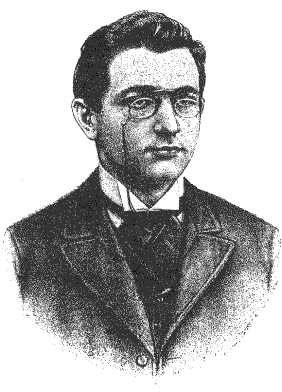 If you are like me, you have a keen interest in chess history. You
also probably have a pretty good chess library, as well as a database to
store and play through games. Unlike some of the contributors to
this site (such as Nick Pope and John Hilbert), you have never visited
your local library and know absolutely nothing about chess newspaper
columns.
But you enjoy reading some of their research and decided to try your
hand
at writing a chess article.
If you are like me, you have a keen interest in chess history. You
also probably have a pretty good chess library, as well as a database to
store and play through games. Unlike some of the contributors to
this site (such as Nick Pope and John Hilbert), you have never visited
your local library and know absolutely nothing about chess newspaper
columns.
But you enjoy reading some of their research and decided to try your
hand
at writing a chess article.
_
I admit that Emanuel Lasker is one of my favorite
players.
I admire his gutsy style and fighting attitude. So I decided to
look
into his championship match versus Wilhelm Steinitz, played in Moscow in
1896. I decided to play through all the games which I already had
in my database and add some notes. Games in my database have
either
been commercially bought or downloaded from one of the chess Internet
sites. |
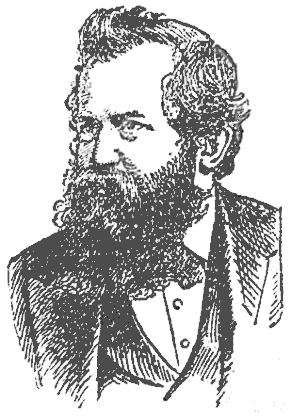 I started by looking at the new book on Lasker by Ken Whyld. I
played
through the first game and noticed that it only had forty-four moves
while
my database had forty-five moves. I then decided to look up the
games
in other books in my library. I started with the German book in
the
Weltgeschichte
series on Steinitz, and noted that it had forty-five moves. I
moved
on to the Weltgeschichte book on Lasker and noted that it only
had
forty-four moves. I then pulled out the Gelo book, Chess World
Championships, and checked out the game. It had the full
forty-five
moves. Finally I looked at the German Biography on Steinitz written by
Bachmann. I do not have the original, which was done in the early
1920’s, but I do have the Olms reprint. Finding the game, I
noted
that it only had forty-four moves. Here is the game that started
my research.
I started by looking at the new book on Lasker by Ken Whyld. I
played
through the first game and noticed that it only had forty-four moves
while
my database had forty-five moves. I then decided to look up the
games
in other books in my library. I started with the German book in
the
Weltgeschichte
series on Steinitz, and noted that it had forty-five moves. I
moved
on to the Weltgeschichte book on Lasker and noted that it only
had
forty-four moves. I then pulled out the Gelo book, Chess World
Championships, and checked out the game. It had the full
forty-five
moves. Finally I looked at the German Biography on Steinitz written by
Bachmann. I do not have the original, which was done in the early
1920’s, but I do have the Olms reprint. Finding the game, I
noted
that it only had forty-four moves. Here is the game that started
my research. |
|
Steinitz,W — Lasker,Em
|
(1)
|
| C54/02 |
Giuoco Piano: Greco (Steinitz)
|
|
|
1.e4 e5 2.Nf3 Nc6 3.Bc4 Bc5 4.c3 Nf6 5.d4 exd4 6.cxd4
Bb4+ 7.Nc3 Nxe4 8.0-0 Bxc3 9.bxc3 d5 10.Ba3 dxc4 11.Re1 f5 12.Nd2 Kf7
13.Nxe4
fxe4 14.Rxe4 Qf6 15.Qe2 Bf5 16.Qxc4+ Kg6 17.Re3 Rae8 18.Rae1 Rxe3
19.Rxe3
h5 20.h3 h4 21.d5 Ne5 22.Qxc7 Nd3 23.Qxb7 Bc8 24.Qc6 Qxc6 25.dxc6 Nf4
26.Re7
a6 27.c4 Kf6 28.Ra7 Nd3 29.Be7+ Ke6 30.Rc7 Ne5 31.Bg5 Rg8 32.Be7 g5
33.c5
Nf7 34.f3 Re8 35.Kf2 Rxe7 36.Rxc8 Kd5 37.Ra8 Ne5 38.Ke3 Nxc6+ 39.Kd2 a5
40.Rf8 Re5 41.f4 gxf4 42.Rxf4 Rh5 43.Ke3 Ne5 44.Ra4 Nc4+
| ** |
And here is the “extra move.” |
45.Kf4 Kxc5 0-1.
| ** |
[This is also the conclusion from my earliest source, the
Daily
Tribune. - Pope] |
|
|
New-York Daily Tribune,
1896.11.22
|
|
Weltgeschichte des Schachs, v11
Lasker,
Wildhagen 1958, 11-185
|
|
Weltgeschichte des Schachs, v7
Steinitz,
Wildhagen 1968, 7-435
|
|
Schachmeister Steinitz, v4, Olms
1980, p214-215
|
|
Chess World Championships, Gelo
1988,
p312
|
|
The Games of Wilhem Steinitz,
Pickard
& Son 1995, p135
|
|
The Collected Games of Emanuel
Lasker,
Whyld 1998, p74
|
|
|
| I was more than a little curious. I decided
to play through game two and compare my various sources. First I
again used the new Lasker book by Ken Whyld and saw the game ended at
move
forty-one. Whyld had listed as his source, Deutsches
Wochenschach
1896, which is a very obscure German magazine. But my database
version
only had thirty-seven moves! I figured this was an easy problem to
solve. After all, this was a World Championship match. I
then
decided to look through some of my books to see how many moves they
had.
I then checked Gelo’s book on World Championships, but instead of
resolving
the discrepancy, Gelo’s book added to it, giving forty-two
moves. |
| In arguably one of the most important chess
matches
of the year, and using two very reliable sources, plus my existing
gamescore,
I had found different versions of the game. Perhaps my other
sources
would resolve this absurdity. I pulled out the
Weltgeschichte
book on Lasker. In looking up the game, I found that it lists
forty-two
moves or the same as Gelo. Feeling better, I opened up the
Steinitz
Weltgeschichte
by the same publisher, and what do I find, but thirty-seven moves, the
same as my database! Finally I looked up my last source, the Olms
reprint on Steinitz. Now I can’t read German, but it appears that
it has
37 moves with White announcing mate in 5. Any way, here is the
game
for your enjoyment. At least, I think it’s the
game—or maybe
it isn’t. I’ve added the various endings. |
|
Lasker,Em — Steinitz,W
|
(2)
|
| C64/04 |
Spanish: Classical
|
|
|
1.e4 e5 2.Nf3 Nc6 3.Bb5 Bc5 4.c3 Nge7 5.0–0 Ng6
6.d4 exd4
7.cxd4 Bb6 8.Nc3 0–0 9.a4 a6 10.Bc4 h6 11.h3 d6 12.Be3 Nce7 13.Re1
c6 14.Qb3
Bc7 15.Nd2 Rb8 16.Rac1 b5 17.axb5 axb5 18.Bd3 Kh8 19.Ne2 f5 20.exf5 Bxf5
21.Bxf5 Rxf5 22.Ng3 Rf8 23.Qe6 Qc8 24.Qxc8 Rfxc8 25.Nb3 Kg8 26.Ne4 Kf7
27.g3 Ke8 28.Re2 Kd7 29.Rce1 Bb6 30.Bf4 Bc7 31.h4 h5 32.Bg5 Bd8 33.g4
hxg4
34.h5 Nf8 35.Nec5+ dxc5 36.Nxc5+
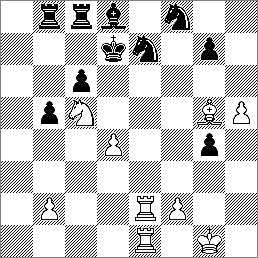 |
[The gamescore published by Pickard terminates here.
-Pope] |
36...Kd6 37.Bf4+
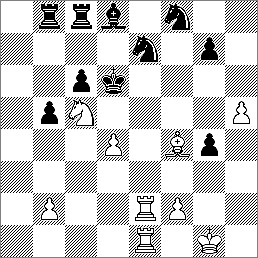 |
And White announced mate in 5 according to Bachmann in
Schachmeister
Steinitz; the game also ends here in Weltgeschichte
Steinitz. |
37...Kd5 38.Re5+ Kc4 39.Rc1+ Kxd4 40.Re4+ Kd5
41.Rd1+
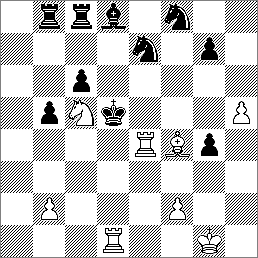 |
Here the game ends according to Whyld. |
41...Kxc5 42.Be3# 1–0.
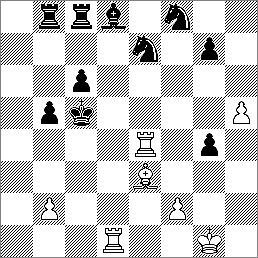 |
According to Weltgeschichte Lasker and Gelo.
[and
Helms in the Eagle.-Pope] |
| ** |
|
The Brooklyn Daily Eagle,
1896.11.22
|
|
Weltgeschichte des Schachs, v11
Lasker,
Wildhagen 1958, 11-186
|
|
Weltgeschichte des Schachs, v7
Steinitz,
Wildhagen 1968, 7-436
|
|
Schachmeister Steinitz, v4, Olms
1980, p215-216
|
|
Chess World Championships, Gelo
1988,
p312-313
|
|
The Games of Wilhem Steinitz,
Pickard
& Son 1995, p135
|
|
The Collected Games of Emanuel
Lasker,
Whyld 1998, p74-75
|
|
|
| Having been exhausted by this struggle, but not
defeated, I decided to look at the next game, game three of the same
match.
Here my database had the game lasting 39 moves. Well guess what,
Whyld’s book, again citing Deutsches Wochenschach 1896, had
only
thirty-four moves. Again, my curiosity piqued, I decided to look
at the same sources. Gelo listed thirty-nine moves as did
Weltgeschichte
Steinitz and they had a different twenty fifth move; however,
Weltgeschichte
Lasker had thirty- four moves as did the Olms Steinitz book. Again major
controversy about a World Championship game! Here is the third
game
along with the various conclusions. |
|
Steinitz,W — Lasker,Em
|
(3)
|
| C54/02 |
Giuoco Piano: Greco (Steinitz)
|
|
|
1.e4 e5 2.Nf3 Nc6 3.Bc4 Bc5 4.c3 Nf6 5.d4 exd4 6.cxd4
Bb4+ 7.Nc3 Nxe4 8.0–0 Bxc3 9.bxc3 d5 10.Ba3 dxc4 11.Re1 Be6 12.Rxe4
Qd5
13.Qe2 0–0–0 14.Ne5 Rhe8 15.Nxc6 Qxc6 16.Re1 Rg8 17.Re5 b6
18.Bc1 g5 19.Rxg5
Rxg5 20.Bxg5 Rg8 21.f4 Bd5 22.g3 Kb7 23.h3 Qb5 24.Kh2 Rg6
25.Qc2
| ** |
Here the different sources diverged with both Whyld and
Weltgeschichte
Lasker giving the following continuation [as does the Evening Journal
-Pope]:
25.Qf2 f6 26.Bh4 Bf7 27.g4 Qd5 28.Qc2 h5 29.g5 fxg5 30.Bxg5 h4 31.Rf1
Rg8
32.Qd2 a5 33.a4 Re8 34.f5 Rg8 0-1. |
25...f6 26.Bh4 Bc6 27.g4 Qd5 28.Qf2 h5 29.g5 fxg5
30.Bxg5
h4 31.Rf1 Rg8 32.Qd2 a5 33.a4 Re8 34.f5 Rg8
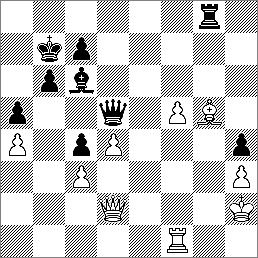 |
Here the game ends according to Bachmann. |
35.Re1 Qxf5 36.Re5 Qf3 37.d5 Qg3+ 38.Kh1 Qxe5 39.dxc6+
Kxc6 0-1.
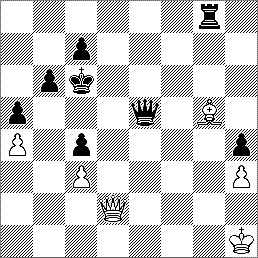 |
According to Gelo and Weltgeschichte Steinitz.
[and Pickard. -Pope] |
| ** |
|
The Albany Evening Journal,
1896.12.05
|
|
Weltgeschichte des Schachs, v11
Lasker,
Wildhagen 1958, 11-187
|
|
Weltgeschichte des Schachs, v7
Steinitz,
Wildhagen 1968, 7-437
|
|
Schachmeister Steinitz, v4, Olms
1980, p216-217
|
|
Chess World Championships, Gelo
1988,
p313
|
|
The Games of Wilhem Steinitz,
Pickard
& Son 1995, p135
|
|
The Collected Games of Emanuel
Lasker,
Whyld 1998, p75
|
|
|
| So much for easy research! Looking at the
first three games of a World Championship match and finding many
different
continuations, what should I do? Since I am not even sure where my
local library is, and if they even have old newspapers, or which ones to
check, I was stumped. Then I did the next best thing. I called my
friend Tony Gillam who is a major chess researcher and asked him for his
advice. His answer after asking me the dates the games were played
(and if that was the old [Julian] or new [Gregorian] calendar) was that
he would check the Russian newspapers the next time he goes to London
for
research. Me, I’m too lazy. |

 If you are like me, you have a keen interest in chess history. You
also probably have a pretty good chess library, as well as a database to
store and play through games. Unlike some of the contributors to
this site (such as Nick Pope and John Hilbert), you have never visited
your local library and know absolutely nothing about chess newspaper
columns.
But you enjoy reading some of their research and decided to try your
hand
at writing a chess article.
If you are like me, you have a keen interest in chess history. You
also probably have a pretty good chess library, as well as a database to
store and play through games. Unlike some of the contributors to
this site (such as Nick Pope and John Hilbert), you have never visited
your local library and know absolutely nothing about chess newspaper
columns.
But you enjoy reading some of their research and decided to try your
hand
at writing a chess article.
 I started by looking at the new book on Lasker by Ken Whyld. I
played
through the first game and noticed that it only had forty-four moves
while
my database had forty-five moves. I then decided to look up the
games
in other books in my library. I started with the German book in
the
Weltgeschichte
series on Steinitz, and noted that it had forty-five moves. I
moved
on to the Weltgeschichte book on Lasker and noted that it only
had
forty-four moves. I then pulled out the Gelo book, Chess World
Championships, and checked out the game. It had the full
forty-five
moves. Finally I looked at the German Biography on Steinitz written by
Bachmann. I do not have the original, which was done in the early
1920’s, but I do have the Olms reprint. Finding the game, I
noted
that it only had forty-four moves. Here is the game that started
my research.
I started by looking at the new book on Lasker by Ken Whyld. I
played
through the first game and noticed that it only had forty-four moves
while
my database had forty-five moves. I then decided to look up the
games
in other books in my library. I started with the German book in
the
Weltgeschichte
series on Steinitz, and noted that it had forty-five moves. I
moved
on to the Weltgeschichte book on Lasker and noted that it only
had
forty-four moves. I then pulled out the Gelo book, Chess World
Championships, and checked out the game. It had the full
forty-five
moves. Finally I looked at the German Biography on Steinitz written by
Bachmann. I do not have the original, which was done in the early
1920’s, but I do have the Olms reprint. Finding the game, I
noted
that it only had forty-four moves. Here is the game that started
my research.